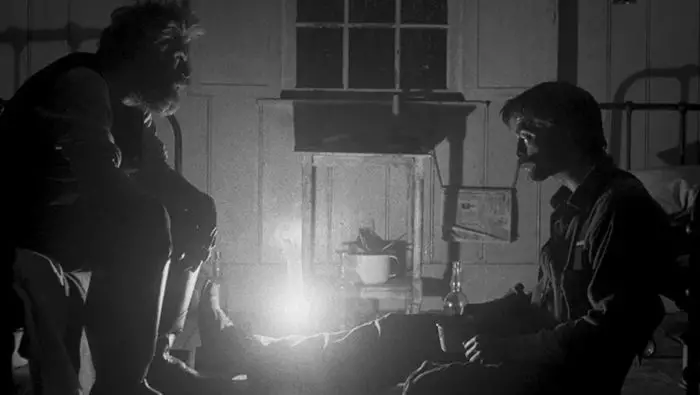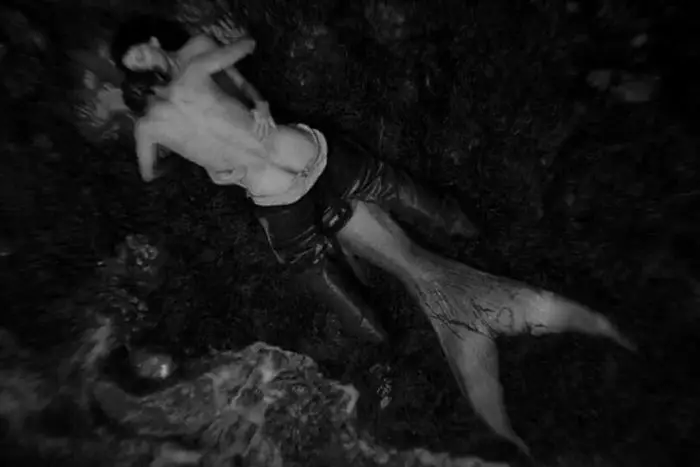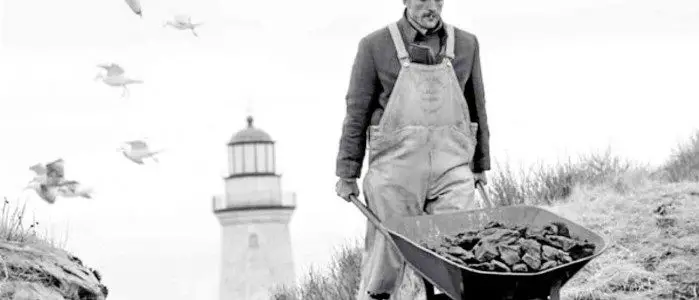Alcohol, Freud & Prometheus: Understanding The Idea Of the Film The Lighthouse (2019). The Hidden Meaning Of The Film “The Lighthouse” , What It Is About, Explanation Of The Ending And Plot Analysis (Review)
Strict and gloomy monochrome. A tower sticking out perpendicular to the ocean like a phallic symbol. Two people in the middle of the waves, stocks of crappy alcohol and screaming seagulls. And the light streaming from the depths of the Fresnel lens is magical, illusory, giving vain hopes for a successful outcome. The meaning of the film “The Lighthouse” is interpreted in different ways. Let’s try to figure it out.
What is the movie about
End of the Victorian era, northeast coast of the United States. An alcoholic and grumpy, loving, sorry, blowing gases, Thomas Wake gets an assistant. Mainland handsome Ephraim Winslow (Robert Pattinson) is temporarily assigned to the lighthouse to help the old man. But in less than a month, the boat will come for the guy.
The newcomer becomes a loader and laborer: the frail veteran exploits him mercilessly. Due to constant stress and alcohol abuse, which he initially refused, the “helper” begins to hallucinate.
Either he sees mermaids, or monsters. Ephraim is forbidden to enter the very top of the structure. The caretaker is jealous, for him to keep the lamp in good condition is like a religion.
Joint libations end with wild revelations. The boss talks about the former assistant, who went crazy and died. The subordinate reveals that he killed the former boss and took his name. Winslow finds out what Tom really thinks about him, and decides to destroy the malicious grandfather. And the plot takes on a heartbreaking “sound”.
“Terrible” Renaissance
The second half of the 2010s became the “Renaissance” for horror. After the “heyday” in the eighties, when they were still full of strength “3 K” (Craven, Carpenter, Cronenberg), horror films experienced a stagnant period.
However, fresh blood still poured in! 30-year-old Robert Eggers took on the filming of the complex, shocking and intricate parable “The Witch”. Shown at the 2015 Sundance Film Festival, the tape made famous both the director and the leading lady Anya Taylor-Joy, who was instantly dubbed the new “scream queen”.
 Film frame
Film frame
Following the young American, Ari Astaire, Jordan Peele and – what’s there – John Krasinski from A Quiet Place loudly announced themselves. Skeptics gloatingly waited for the failures of yesterday’s debutants. But the former director of “Reincarnation” produced an even more amazing “Solstice”, and the second one after “Get Out” presented the curious suspense “Us”.
We still have a vague idea about the science fiction sequel about blind monsters: due to the pandemic, the premiere of the film was postponed. What is interesting: each master has his own idea, and the implementation too. Therefore, movie fans of the genre can rub their hands with pleasure.
When colleagues “shot”, everyone was waiting for what Eggers could answer. And his offspring turned out to be the most important troublemaker. Because it caused controversy and gave rise to incredible versions.
The charm of light and shadow
The members of the Cannes 2019 jury were the first to see the tape – the work of the American was included in the “Directors’ Fortnight” competition and was awarded the FIPRESCI award (it is awarded by the Federation of Film Journalists). A distinctive feature of the shooting is the vintage (narrowed) aspect ratio, in which part of the action is, as it were, “hidden” from the viewer. The 35mm film and orthochromatic aesthetic are reminiscent of 19th century daguerreotypes. Everything is very clear, and no color.
Agree: black-and-white films made by our contemporaries are not a frequent phenomenon and are almost always unique. The Artist won an Oscar for best film of the year. And recently, the premiere of the current Academy Award winner, Parasite, deprived of color, took place.
Bong Joon Ho admitted that he conceived the picture as black and white, but “went on about marketing.” If you review this version, you will discover even more hidden meaning of the Korean masterpiece.
Interpretation of archetypes according to Jung
Coming up with the plot of The Lighthouse, Eggers was inspired by the works of Carl Jung. In the script, the headline construct is described as an “erect penis.” In the draft version of the film, the juxtaposition of the structure and Winslow’s reproductive organ was visible, but the producers asked that this fragment be removed.
The director said in an interview that Ephraim is obsessed with the caretaker, this is a kind of Oedipus complex. Robert Pattinson emphasized that the fear of the crazy old man is mixed in his character with admiration and even lust.
Critics caught the homosexual subtext of what was happening (citing facts: compliments on the beauty of the assistant, hints about tentacles and lobsters, elements of BDSM in relation to Wake). But Eggers urged the audience not to get hung up on homoerotica and asked them to forget about sexuality altogether. Although it’s hard to do, allusions are everywhere, from the mermaid figurine to Willem Dafoe on a leash.
 Film frame
Film frame
How did the movie end
Having planned to kill the hated drunkard, Winslow (aka Howard) almost buried the enemy, and then stopped his attack. When the only person standing between him and the lighthouse lamp was finished, the hero rushed up to satisfy his curiosity.
Opening the “sash”, Ephraim was amazed by what he saw and began to utter heartbreaking cries. Stepping back, the assistant rolled down the steps. The last shots: a young man lies on the shore, and the ever-hungry seagulls peck at his flesh. This eerie picture is replaced by credits under a rollicking song that contrasts sharply with what has just been seen.
The meaning of the ending
When they begin to argue – what is the meaning of the ending of the film “The Lighthouse”, they most often mention Greek mythology (which the author was also inspired by – as well as the works of Melville). The allegory with Prometheus suggests itself.
Having received the light of the knowledge of the gods, Prometheus decided to share them with people and was punished. The eagle tormented the liver of the man chained to the rock every day, and so it went on for eternity. Winslow finally saw what was hidden in the lamp (this was not revealed to the audience). And doomed to be fed by greedy birds.
Defoe’s character is compared to the prophet and servant of Poseidon. Because the old man accurately predicts how his assistant will die. And the extravagant assistant sees tentacles wriggling around the lame-footed head.
The second explanation of the ending is banal and lies on the surface. Two men went crazy in isolation. And alcohol “finished off” both: they drank to delirium tremens and paranoia. The young one saw the sea “devils”, decided that the elderly had planned the murder, and got ahead of the enemy.
The third way to find the essence of the tape is the most eccentric. Allegedly, Thomas has a split personality. He grew old working at the lighthouse and went mad. The desire to break free was materialized in a young alter ego. But the service of duty wins, hence the confrontation between the two personalities living in the poor fellow. Difficult, tricky, but interesting.
 Film frame
Film frame
Jumping from the twilight saga
Whatever your personal explanation for the film, its artistic merits are clear. No wonder the cameraman Djarin Blaschke, who subtly and skillfully built each frame, was nominated for an Oscar. And both actors of the chamber “cinema for two” claimed the “Independent Spirit” award. Willem Dafoe won. Other “laurels” of the artist are “Satellite” and nominations for “Gotham” and “Critics’ Choice”.
Pattinson is compared by film critics to Daniel Day-Lewis in the drama Oil. This is high praise, considering that the Briton received a lot of awards for the role of the madman Plainview, including an Oscar. As you know, the star of the Twilight franchise zealously sought to “go as far as possible” from the image of the sugary vampire Cullen, which he hated. He succeeded.







